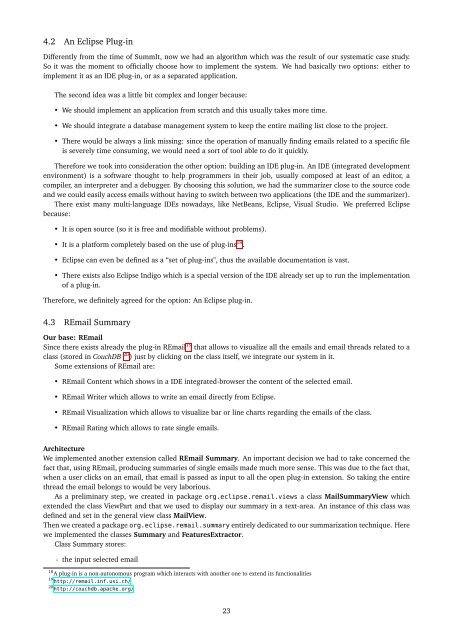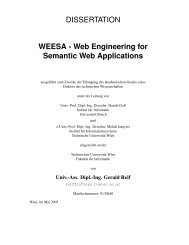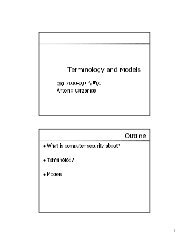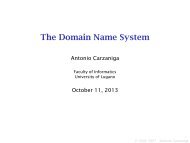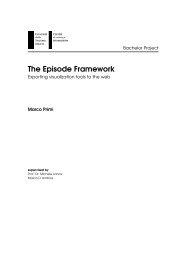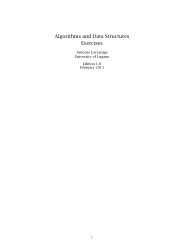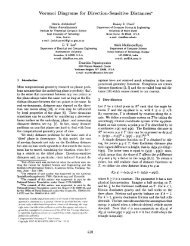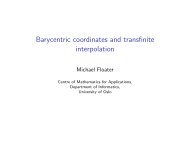Extractive Summarization of Development Emails
Extractive Summarization of Development Emails
Extractive Summarization of Development Emails
Create successful ePaper yourself
Turn your PDF publications into a flip-book with our unique Google optimized e-Paper software.
4.2 An Eclipse Plug-in<br />
Differently from the time <strong>of</strong> SummIt, now we had an algorithm which was the result <strong>of</strong> our systematic case study.<br />
So it was the moment to <strong>of</strong>ficially choose how to implement the system. We had basically two options: either to<br />
implement it as an IDE plug-in, or as a separated application.<br />
The second idea was a little bit complex and longer because:<br />
• We should implement an application from scratch and this usually takes more time.<br />
• We should integrate a database management system to keep the entire mailing list close to the project.<br />
• There would be always a link missing: since the operation <strong>of</strong> manually finding emails related to a specific file<br />
is severely time consuming, we would need a sort <strong>of</strong> tool able to do it quickly.<br />
Therefore we took into consideration the other option: building an IDE plug-in. An IDE (integrated development<br />
environment) is a s<strong>of</strong>tware thought to help programmers in their job, usually composed at least <strong>of</strong> an editor, a<br />
compiler, an interpreter and a debugger. By choosing this solution, we had the summarizer close to the source code<br />
and we could easily access emails without having to switch between two applications (the IDE and the summarizer).<br />
There exist many multi-language IDEs nowadays, like NetBeans, Eclipse, Visual Studio. We preferred Eclipse<br />
because:<br />
• It is open source (so it is free and modifiable without problems).<br />
• It is a platform completely based on the use <strong>of</strong> plug-ins 18 .<br />
• Eclipse can even be defined as a “set <strong>of</strong> plug-ins", thus the available documentation is vast.<br />
• There exists also Eclipse Indigo which is a special version <strong>of</strong> the IDE already set up to run the implementation<br />
<strong>of</strong> a plug-in.<br />
Therefore, we definitely agreed for the option: An Eclipse plug-in.<br />
4.3 REmail Summary<br />
Our base: REmail<br />
Since there exists already the plug-in REmail 19 that allows to visualize all the emails and email threads related to a<br />
class (stored in CouchDB 20 ) just by clicking on the class itself, we integrate our system in it.<br />
Some extensions <strong>of</strong> REmail are:<br />
• REmail Content which shows in a IDE integrated-browser the content <strong>of</strong> the selected email.<br />
• REmail Writer which allows to write an email directly from Eclipse.<br />
• REmail Visualization which allows to visualize bar or line charts regarding the emails <strong>of</strong> the class.<br />
• REmail Rating which allows to rate single emails.<br />
Architecture<br />
We implemented another extension called REmail Summary. An important decision we had to take concerned the<br />
fact that, using REmail, producing summaries <strong>of</strong> single emails made much more sense. This was due to the fact that,<br />
when a user clicks on an email, that email is passed as input to all the open plug-in extension. So taking the entire<br />
thread the email belongs to would be very laborious.<br />
As a preliminary step, we created in package org.eclipse.remail.views a class MailSummaryView which<br />
extended the class ViewPart and that we used to display our summary in a text-area. An instance <strong>of</strong> this class was<br />
defined and set in the general view class MailView.<br />
Then we created a package org.eclipse.remail.summary entirely dedicated to our summarization technique. Here<br />
we implemented the classes Summary and FeaturesExtractor.<br />
Class Summary stores:<br />
- the input selected email<br />
18 A plug-in is a non-autonomous program which interacts with another one to extend its functionalities<br />
19 http://remail.inf.usi.ch/<br />
20 http://couchdb.apache.org/<br />
23


